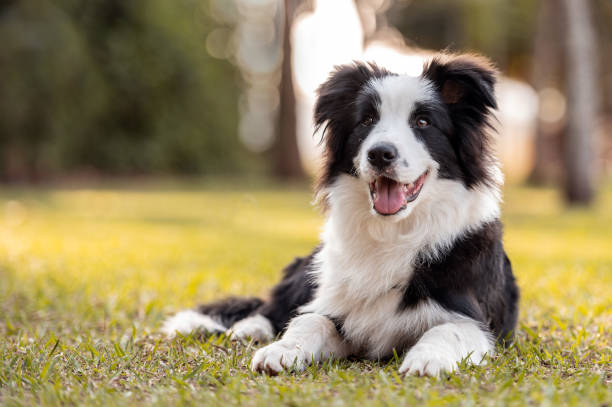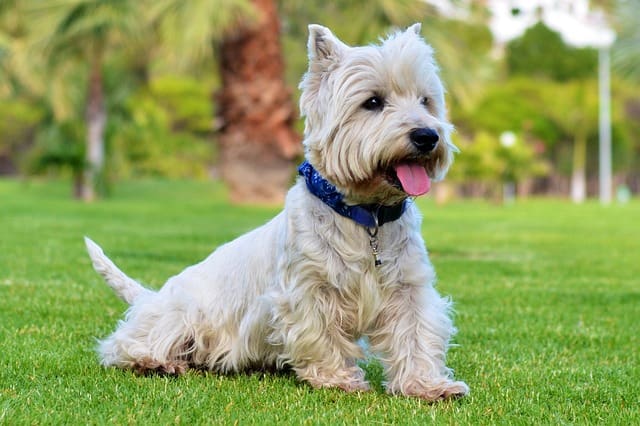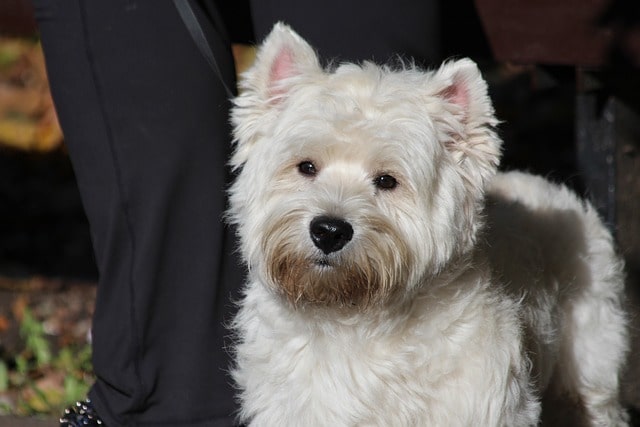In the world of dogs, two popular breeds, these are the Border Collie and the Westie, stand out with their unique characteristics and temperament, captivating the hearts of dog enthusiasts worldwide. As we explore these remarkable breeds, we uncover a tale of diverse attributes, unwavering loyalty, and unparalleled companionship, leaving dog lovers enchanted by their allure.
Characteristics of a Border Collie versus West Highland White Terrier

Border Collie is widely known for its incredible level of intelligence and boundless energy. They are highly trainable and enjoy learning new commands, making them a pleasure to work with. However, their high energy levels require plenty of exercise and attention from their owners to keep them happy.
The West Highland White Terrier, also known as the Westie, is a small and lively terrier from Scotland. They are intelligent, independent, and a bit stubborn, requiring a patient yet firm training approach. Despite their size, they need regular exercise to stay healthy and cheerful. Their friendly nature, adorable appearance, and pure white, medium-length coats make them popular companions for active individuals and families.
Simply put, Border Collies are ideal for owners who are:
- Highly active
- Love training and mental challenges
- Can devote plenty of time to exercise and play
West Highland White Terriers are a better match for individuals or families who want a smaller, friendly companion, are moderately active, and can offer patient training with regular exercise to keep their Westie happy.
History of Breeds
The Border Collie was specifically bred to excel at herding sheep in the borderlands between Scotland and England. Over time, different types within the breed, such as the Rough Collie and Bearded Collie, emerged due to their exceptional working abilities and adaptability to the demands of the wool trade. Through careful breeding and influence from various working and sporting breeds, the Border Collie became highly valued by flock owners, earning its name as the “Border Collie.”
The West Highland White Terrier, also known as Westie, hails from Scotland. This canine breed holds a significant position as a brave hunter of creatures like foxes, badgers, otters, and rodents like rats. In the company of fellow short-legged terrier companions native to Scotland—like the Scottish, Skye, Cairn, and Dandie Dinmont Terriers—the Westie stood out due to its remarkable prowess in hunting.
Appearance Comparison
The Border Collie is recognized for its intense stare, which it uses to control its flock. It has a slightly longer body than its height, displaying a strong and agile physique on a lean frame. The head resembles that of a collie, and its ears stand upright, but the tips drop over, creating a confident appearance. Border Collies’ tails are left long and bushy, always in motion, constantly wagging.
The West Highland White Terrier, or Westie, is a small and robust dog breed. They have a compact body and a tail shaped like a carrot that wags delightfully. When viewed from the front, their head appears round and is proportionate to their body. The muzzle is blunt and slightly shorter than the skull, tapering toward the nose. Their eyes are almond-shaped, deep-set, and dark brown, set wide apart, giving them a distinctive look. Westies have pointed and erect ears.
Border Collie possesses a commanding and intense stare, utilizing their strong and agile physique to control their flock. At the same time, the West Highland White Terrier showcases a charming appearance with its compact body, distinct head shape, and wagging carrot-like tail.
Size
Border Collies are medium-sized dogs, males standing approximately 19 to 22 inches tall and females measuring 18 to 21 inches tall. On average, Border Collies’ height falls within the range of 22 to 27 inches.
As for weight, adult female Border Collies usually weigh between 30 to 45 pounds, while adult males weigh around 40 to 55 pounds. The average weight of Border Collies generally falls between 27 to 45 pounds. Their body length typically ranges from 28 to 34 inches. Remember that individual Border Collies may deviate from these standard measurements, and their growth may continue until they are 15 to 18 months old. West Highland White Terriers, also known as Westies, are small to medium-sized dogs known for their distinctive white coat. Generally, Westies stand between 10 to 11 inches tall at the shoulder and weigh around 15 to 20 pounds.
Simply speaking, Border Collie is a medium-sized, brilliant, and energetic breed, while the West Highland White Terrier is a smaller, friendly, and independent breed. Both dogs have distinct characteristics and are well-suited for owners with different preferences and activity levels.
Coats & Colors
The West Highland White Terrier and the Border Collie are distinct breeds known for their unique coat characteristics, appealing to different preferences among dog enthusiasts. For instance, the West Highland White Terrier is recognized for its striking all-white coat. This coat consists of two layers—a short, dense undercoat and a longer, harsh-textured topcoat measuring approximately two inches. This combination offers excellent protection against weather elements and provides a degree of insulation. The coat has a firm and wiry texture when touched, giving it a distinctive feel.
On the other hand, the Border Collie showcases a completely different type of coat. It, too, is double-layered, offering ample protection and insulation. The Border Collie’s topcoat is typically medium-length, dense, and weather-resistant, while its undercoat is soft and thick. This coat adaptation helps the breed withstand various weather conditions during herding. Unlike the all-white coat of the West Highland White Terrier, the Border Collie’s coat is available in different patterns and colors similar to:
- Black and white
- Red and white
- Tri-color combinations, typically black, white, and tan markings.
Furthermore, it’s important to note that the Border Collie’s coat comes in rough and smooth variations. Rough-coated Border Collies have a dense, medium-length outer coat and a soft undercoat, offering enhanced protection in diverse weather conditions. Conversely, smooth-coated Border Collies have shorter fur, which is still weather-resistant, enabling them to excel in their herding responsibilities.
Personality & Temperament Difference
Border Collies are highly intelligent, energetic, hardworking dogs with strong herding instincts. However, their sensitivity requires proper socialization during puppyhood to prevent fearfulness or shyness.
They are exceptionally trainable and responsive to commands, often seeming to anticipate their owner’s desires.
Their versatility makes them suitable for various tasks, such as:
- Herding on farms
- Mountain rescue
- Sniffing duties
Westies are smart, independent, and a little stubborn, but they possess enough self-assurance that they don’t need constant pampering. Despite their strong-willed nature, they can be affectionate and loyal, making them excellent companions, especially for first-time or inexperienced dog owners. They are adaptable and generally do well in multi-dog homes, but caution is needed when there is more than one intact male among them.
Their adaptability and intelligence can sometimes translate into stubbornness, which may present a challenge during training. A firm and consistent hand and positive and consistent training methods will be necessary to bring out the best in these delightful Westies.
Border Collies are brilliant, energetic, and versatile dogs with strong herding instincts. They excel in herding, rescue work, and sniffing duties. Proper socialization during puppyhood is crucial due to their sensitivity. Westies are intelligent, independent, and affectionate and make excellent companions, especially for first-time dog owners. They can be stubborn during training, but a firm and consistent approach is essential for positive results.
Family

Border Collies and Westies possess unique traits that make them wonderful additions to family households. The Border Collie’s unwavering enthusiasm for various activities and eagerness to please their owners demonstrate their rapid learning capabilities.
Similarly, the Westies’ cheerful and friendly nature makes them excellent family companions, and their courage and resilience make them dependable watchdogs. Engaging in walks, hikes, and playful games strengthens the bond between these affectionate dogs and their adoring owners.
Kids
While Border Collies generally get along well with children, some Westies may not be as tolerant of young ones as others. Awareness of these individual differences is essential when considering these breeds as family pets.
Border Collies and Westies can be great companions for children due to their friendly and active temperaments. However, it’s important to remember that each dog is unique, and their tolerance towards kids may vary.
Other People
Border Collies are generally friendly towards strangers but can be selective in their preferences. Proper socialization during the early stages is vital to build confidence and ensure they grow into well-behaved adult dogs. Insufficient socialization might lead to hostility towards other dogs and animals or trigger fearful and shy tendencies, which could result in aggressive behavior.
Westies are known for their friendly and pleasant nature. They easily get along with everyone, including unfamiliar individuals. Unlike being attached to just one person, Westies are affectionate companions for everyone. Their adventurous spirit makes them ever-ready for a chase, and they thoroughly enjoy exploring their surroundings.
Dogs & Other Animals
Border Collies are recognized for their friendly nature, although they may exhibit reserved behavior around strange animals and dogs. Proper socialization is vital to prevent them from developing hostility. Early socialization also helps to address any shyness or fearfulness they may display. Attending puppy classes is highly beneficial for these sensitive dogs.
In contrast, Westies are generally friendly and can get along well with other dogs and animals, making them suitable for multi-dog households. However, they have a strong instinct to chase other animals, so close supervision during interactions and, at the same time, proper socialization and consistent training are critical to ensure their positive behavior.
Behaviour Issues
Lack of proper exercise and mental engagement may lead to boredom and destructive behaviors. Additionally, extended periods of being alone could trigger separation anxiety. To promote their well-being, it is crucial to establish a consistent daily routine and maintain a calm household environment, avoiding excessive noise and frequent guest visits.
Westies are known for their tendency to bark and howl frequently, indicating their high vocalization nature. Without proper guidance, they may develop troublesome behaviors, such as irritable snapping and excessive excitement, potentially leading to biting incidents. Hence, appropriate training and socialization are essential to prevent aggression and biting tendencies in these dogs.
On the other hand, if you notice that your dog, whether a Border Collie or Westie has a specific behavioral problem, hiring an experienced dog trainer may be ideal. Besides, seeking assistance from a qualified behaviorist can address your dog’s behavior problems, such as:
- Resource guarding
- Handling issues
- Separation anxiety
- Aggression towards others
A dog trainer can help with obedience training, providing faster results and valuable expertise. They will also teach you how to continue training your dog effectively.
Training & Exercise
Border Collies are highly intelligent and responsive to training, requiring physical exercise and mental stimulation to prevent behavioral issues. Incorporating command practice while playing with a frisbee and engaging in agility training can be effective. They need a minimum of 2 hours of exercise daily.
West Highland White Terriers are easily trainable with positive reinforcement and consistent methods. Obedience workouts and playful ball games bring out their best qualities. They need 60 to 90 minutes of daily exercise, typically achieved through two brisk half-hour walks.
Taking Care & Maintenance
The West Highland White Terrier, or Westie, has a dense undercoat and rough topcoat that requires daily grooming to keep its fur clean and tangle-free. To prevent dermatitis, using medicated shampoo during baths can be beneficial. Feeding adult Westies up to 20 pounds with approximately 800 calories of high-quality dog food is recommended.
They are intelligent and quick learners, making positive and enjoyable training methods ideal. Their active nature requires mental stimulation, achieved through engaging walks and playtime in a secure, enclosed yard for their well-being.
Border Collies have a dense double coat, requiring regular brushing to prevent matting, and baths should be given only as necessary for coat health. Renowned for their high intelligence and trainability, they excel in obedience and agility competitions.
Consistent and positive training methods are crucial to harnessing their potential. These energetic dogs need daily exercise and mental stimulation to remain content and healthy, contributing to their happiness and well-roundedness. Keeping them engaged in regular physical activities is essential for their well-being.
Grooming a Border Collie versus Westie

Grooming is crucial for ensuring the well-being of our furry companions. Fortunately, both Border Collies and West Highland White Terriers have grooming needs that are easy to manage.
| Border Collie | Westie |
| Brushing – To keep your Border Collie’s coat in good condition, brushing them before bathing. This helps remove dead hair and prevents matting. | Brushing – To maintain your Westie’s coat in good condition, it’s recommended to brush them every day using a slicker brush, which helps remove dead hair and prevent matting. |
| Trimming – For show standards, only minimal trim around the feet and back of the legs is necessary to give a tidier appearance to a Border Collie. | Trimming – Trimming your Westie’s coat every few months is advised. When using electric pet clippers, apply gentle pressure and trim following the growth of the fur. Use scissors to tidy up any excess fur on your pet’s head and face. |
| Bathing – Bathing your Border Collie should be done at most once every 3-4 months. Frequent bathing can strip away the natural oils in their fur, leading to potential skin issues. | Bathing – As a general guideline, Westies should be bathed every four to six weeks, but some show owners only wash their Westies three or four times a year. |
On the other hand, if you don’t have clues on grooming your dog, there’s always the option to hire professional groomers. There are good reasons working with the pros too like:
- Professional pet groomers enhance your dog’s appearance and safety. They identify and treat skin issues, cuts, and thorns, using antiseptic solutions when needed.
- Nail trimming becomes hassle-free with professional groomers. They have the experience and proper tools for safe and efficient trimming.
- Professional groomers offer stylish and breed-appropriate haircuts that showcase your dog’s individuality.
- Experienced groomers have the necessary supplies to cater to the specific needs of different dogs.
- Professional groomers provide soothing massages that reduce stress and anxiety in your dog.
Shedding
The Border Collie and the West Highland White Terrier have distinct shedding characteristics. Border Collies experience year-round shedding, which intensifies during the summer months. Regular brushing, at least twice a week, is essential to manage their shedding effectively. On the other hand, West Highland White Terriers differ significantly, as they do not shed considerably.
Despite their minimal shedding, both breeds require grooming efforts to maintain the quality of their coats. While Border Collies demand more attention due to their shedding, Westies need grooming to keep their coat in good condition without excessive shedding.
Health Comparison between Border Collie and West Highland White Terrier
When considering the health of our beloved canine companions, it is essential to acknowledge that some dog breeds are generally healthier than others. Border Collies and West Highland White Terriers are popular and beloved breeds. However, like all breeds, they are not entirely immune to health issues.
Life Span

Border Collies are known for their robust health and can live longer than many other breeds of similar size, typically having an average lifespan of 12 to 15 years. Some exceptional individuals have even reached the age of 17 or 18, with one remarkable Border Collie named Bramble living an impressive 25 years.
West Highland White Terriers, on the other hand, have a typical life expectancy of 12 to 16 years and, with proper care, can thrive well into their late teens. Male Westies generally live around 13.8 years, while females Westies are expected to live around 12 to 13 years.
Diet & Nutrition
Border Collies and West Highland White Terriers have distinct dietary needs to support their active lifestyles and overall health. A diet rich in animal-based proteins promotes muscle development and energy levels in both breeds. Some good examples that you can incorporate on their diet include:
- Beef
- Chicken
- Turkey
- Lamb
- Duck
- Eggs
- Fish
Selecting size-appropriate food, especially during the puppy stage, is crucial. Feeding frequency and portion control are important considerations.
Health Issues
Whether you have a Border Collie or a West Highland White Terrier, no breed is immune to sickness and diseases. The best way to protect them from such circumstances is to be prepared.
Understanding the common health issues that affect each breed and knowing how to handle such situations will guide you in taking appropriate action.
For instance, Border Collies are prone to health issues such as hip dysplasia, epilepsy, Collie Eye Anomaly, hypothyroidism, and dental problems. These conditions are not the fault of their owners but are unfortunately inevitable for some individuals of the breed.
- Hip Dysplasia – One of the most prevalent health concerns seen in Border Collies is hip dysplasia, where the hip joint ball does not fit properly into its socket. If left untreated, it can cause discomfort, pain, and limited mobility in affected dogs.
- Epilepsy – Unfortunately, Border Collies are also prone to Canine Epilepsy, a neurological disorder that results in unpredictable and sometimes life-threatening seizures. This condition requires careful management and medical attention to support the affected dog and its owner.
- Collie Eye Anomaly – Collie Eye Anomaly is another genetic health issue affecting this breed. The severity of the condition can vary, with symptoms ranging from mild to complete blindness. Regular veterinary check-ups and early detection are crucial for effectively managing this potentially sight-threatening condition.
- Hypothyroidism – This is a condition in which the thyroid gland fails to produce sufficient thyroid hormone. This imbalance can lead to various symptoms, including weight gain, lethargy, and skin problems. Regular monitoring of the dog’s thyroid levels and appropriate medical intervention can improve the quality of life for affected Border Collies.
- Dental Problems – Besides genetic and neurological conditions, Border Collies are susceptible to dental problems due to their natural chewing tendencies. Tartar buildup and cavities can occur, requiring proper dental care and regular teeth cleaning to maintain oral health.
Westies are recognized as purebred canines requiring specialized care and devoted attention due to their susceptibility to various health complications. Among these issues are joint-related ailments, including conditions such as hip dysplasia, craniomandibular osteopathy (swollen jaw), luxating patella (loose knees), and Legg-Calve-Perthes disease (hipbone atrophy). Diligently overseeing the well-being of their joints is of utmost importance to guarantee their ease and freedom of movement.
- Skin problems – Skin problems are a common concern among Westies, particularly allergies that are prevalent in terrier breeds. A recent study revealed that approximately two-thirds of this breed experience skin disease by age three. Vigilance about their pet’s skin health and prompt veterinary care for any issues is crucial for owners.
- Digestive diseases – Digestive diseases are another area of concern for Westies. They are susceptible to colitis (inflammatory bowel disease) and pancreatitis. Proper diet maintenance and regular veterinary check-ups play a significant role in managing and preventing digestive problems.
- Urinary issues – Westies are also prone to urinary issues, with concerns about urinary stones and their susceptibility to bladder cancer. Monitoring their urinary health and ensuring adequate hydration can help minimize the risk of such conditions.
- Heart problems – Unfortunately, this is common among Westies and can lead to severe issues, including heart failure. Regular check-ups with a veterinarian and early detection of heart-related problems are essential to improve the dog’s quality of life and longevity.
- Cushing’s disease – Cushing’s disease, a hormonal disorder, can affect Westies and may lead to increased thirst and urination, weight gain, and hair loss.
- Addison’s disease – Westies might also be susceptible to Addison’s disease, which can cause symptoms such as vomiting, diarrhea, lethargy, and weight loss. Timely identification and treatment of these hormonal imbalances are crucial for effectively managing the dog’s health.
To sum up, West Highland White Terriers make fantastic and affectionate companions. However, their health requires special attention due to potential issues. With proactive care, regular veterinary visits, and prompt action when health concerns arise, owners can ensure that their Westies enjoy happy and healthy lives.
Cost of breeding a Border Collie versus a Westie
Breeding a dog regardless if it is a Border Collie or Westie, comes with various associated costs. Get a better understanding of what it entails to breed one by reading the next lines.
| Expense | Cost |
| Initial Cost | Acquiring a female purebred dog with breeding rights can cost between $1,000 to $5,000. If you want to use a stud dog for breeding, the fee can vary from $750 to several thousand dollars. Additionally, obtaining American Kennel Club (AKC) registration for the mother dog typically costs around $75. |
| Health Testing | Health testing for breeding dogs, which includes hip and elbow testing and breed-specific DNA tests, can amount to approximately $1,000. Additional examinations like eye tests may lead to other costs. |
| Care and Maintenance | Regular veterinary check-ups, vaccinations, and preventive medications for the mother dog and puppies are essential and contribute to the overall expenses. Providing high-quality food and supplements for the mother during pregnancy and lactation and for the puppies is also a necessary cost. Additionally, whelping supplies may be needed, including whelping boxes, bedding, heating pads, and digital scales for weighing the puppies. |
Breeding dogs like Border Collies or Westies requires careful financial planning. Expenses include acquiring a purebred female with breeding rights, fees for a stud dog, health testing, regular vet check-ups, vaccinations, and preventive medications for the mother and puppies. High-quality food and supplements during pregnancy and lactation are essential. Aspiring breeders must be prepared and responsible to ensure the dogs’ well-being.
Puppies
Knowing the typical costs is important when considering getting a new furry companion. The West Highland White Terrier, or Westie, can be found from reputable breeders at an average price of approximately $1,000. However, it’s essential to note that the price range for a Westie usually falls between $1,500 to $2,080, depending on factors like lineage, pedigree, and breeder reputation.
If you’re interested in getting a Border Collie, another wonderful canine companion, the price range for a puppy is generally more affordable. Border Collies are known for their intelligence and herding abilities, making them popular among active and engaged dog owners. The price for a Border Collie puppy ranges from $600 to $800.
West Highland White Terrier and the Border Collie are lovely breeds, but the Westie tends to be more expensive, with a wider price range due to various factors. On the other hand, the Border Collie offers a more budget-friendly option for those seeking an energetic and intelligent canine companion. Regardless of the breed, ensuring the puppy’s well-being by finding a reputable breeder should always be a top priority.
Breeders & Centers
When considering the costs of getting a dog, it’s important to exercise caution, as prices can vary based on several factors. The geographic location can significantly impact prices, with certain regions commanding higher dog fees. Reputable breeders, known for producing healthy and well-cared-for dogs, may also charge more for their puppies.
The dog’s lineage and pedigree are also crucial factors affecting the price. Puppies from champion bloodlines or with show-quality potential usually command a higher price than those without such prestigious lineage. Additionally, unique coat colors or exceptional abilities can influence the price of a puppy.
To help you find respected breeders and centers, you may consider doing the following:
- Meeting the Breeder in Person or Virtually: The most effective way to acquaint yourself with a breeder is through a personal meeting at their kennel or home. If an in-person visit is not feasible, consider arranging a video conference with the breeder and their dogs.
- Involvement in Breed Clubs: Assess the breeder’s level of engagement in breed clubs. Check if they hold any positions or participate in committees. It’s a positive sign if they attend national specialty events bringing breed enthusiasts together. Additionally, membership in regional or local clubs dedicated to the breed is a good indicator of commitment.
- Seek Referrals: Obtain recommendations from knowledgeable sources to find a reputable breeder. Your veterinarian, who interacts with many puppies, could be a valuable reference. Likewise, inquire about the origin of a friend’s dog if you admire their pet, as reliable breeders often gain recognition through positive word-of-mouth referrals.
- Verify Documentation: Once you have selected a breeder, ensure you receive proper documentation for your puppy’s pedigree. This information will provide valuable insights into the lineage and ancestry of your new companion.
- Assess the Breeder’s Goals: Look for breeders who prioritize more than just profit. A responsible breeder’s primary objective should be to produce healthy, well-balanced dogs that serve a specific purpose or function. Their dedication to the breed’s well-being is crucial in ensuring you receive a suitable companion.
Conclusion: Which Is Better, Border Collie or West Highland White Terrier?
Choosing between the Border Collie and the West Highland White Terrier can be challenging due to their unique traits, catering to different lifestyles. To make an informed choice, it’s essential to understand the distinct qualities of each breed.
The Border Collie’s exceptional intelligence and trainability make it a perfect fit for experienced owners who can provide the mental stimulation and vigorous exercise. Active individuals or families willing to invest time and effort into their dog’s needs will find an excellent companion in this breed. However, potential health issues should be considered.
In contrast, the West Highland White Terrier, or Westie, offers a more relaxed temperament, making it an attractive option for first-time dog owners. While it still requires moderate exercise and mental engagement, its needs are more manageable, making it suitable for individuals with a less active lifestyle. Regular vet check-ups are necessary to address possible health concerns such as skin allergies and luxating patella.
Both breeds generally get along well with children, though individual temperaments may vary. Ultimately, the decision should be based on lifestyle, living situation, and personal preferences.


